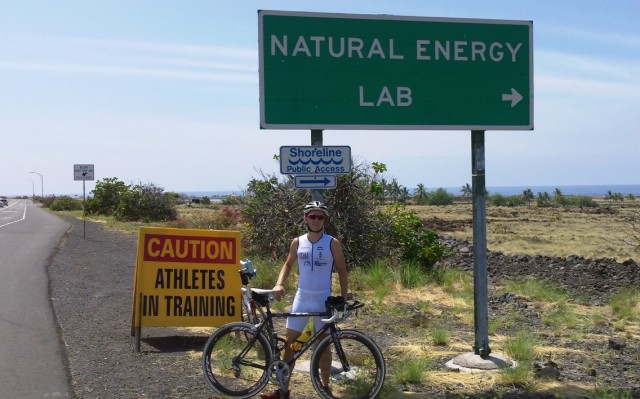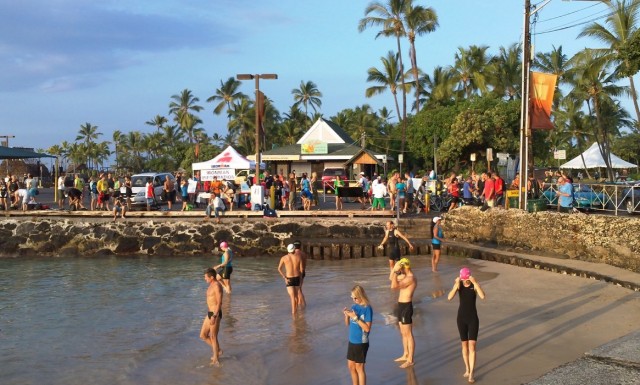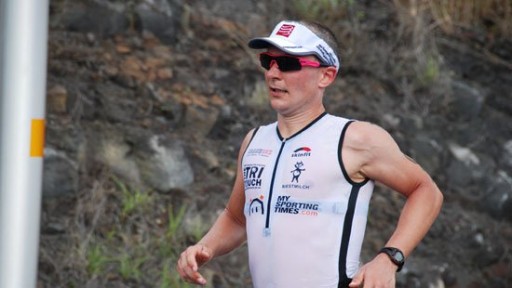Three of my athletes have qualified for the Ironman World Champs this year. They’re all first timers in Kona and keen to make the most of their time there. The following is an email I sent to them offering some guidance and pointers based on my experiences racing on the island. It’s been edited a little for clarity and because it ended up so much longer than I’d expected.
It’s been 5 years since I last raced in Hawaii so things may have changed. At the very least you’ll have a few more competitors to deal with and a race start staggered by gender.
As a race two things make Hawaii stand out from others: the conditions on the island and the level of competition. It’s the heat, humidity and strong winds that make this course so challenging. Alongside this there are a lot of closely packed athletes meaning there will be periods when the course is crowded. Controlling effort in these circumstances can be challenging.
The main thing I’d advise is to enjoy everything that’s different about this event, but treat the race itself like any other Ironman. Turn up, execute a solid race day plan and you’ll be fine. Heroics might leave you walking through the energy lab with six miles still to go. I can tell you the views out there are stunning, but the prospect of walking back to town isn’t.
Pre-race:
Coming from October in the UK training in Kona will feel terrible to start with. This is normal. You’re not well adapted to the heat and humidity and you’ll be jetlagged too. Don’t fight it, go by feel and adjust sessions accordingly. Don’t stress when you miss your usual heart rate or power numbers, or that the effort feels much higher. It will get better with time, you just have to keep doing your taper training and sweating it out.
Given this, don’t neglect hydration – it’s pretty easy to dehydrate out there. There’s a lot of coffee on offer in Kona, that alone won’t cut it. I should also mention sunscreen. You’re British, you’ll burn easily. Protect yourself throughout race week and especially on race day. You could still see my race number for weeks after the finish (you may consider this a pro when returning to club swims back home).
Along side the physical stresses are mental ones – this is the Ironman World Champs everyone is lean and ripped and looks like they’re in peak form. A lot of them are. You may not fully appreciate it, but you’re one of them.
By the time you land on the island there’s nothing more you can do. It’s the taper, stay relaxed. Ignore the other athletes and enjoy the experience.
I’ll emphasise that: enjoy your time out there. From a race perspective it’s easy to do too much in race week, taking in too many sights and taking part in too many activities. From a race perspective you need to rest and relax when not taper training. But how often do you go to Hawaii? It’s not a cheap trip, make the most of it. If I’m honest, I wish I’d been more of a tourist.
Swim:
This is the toughest Ironman swim you’ll likely encounter. It favours strong swimmers. Most athletes qualified by being fast in their age group which means there’s a lot of people swimming a similar time to you. Expect this course to be crowded. To avoid the worst of it you might choose to go wide of the buoys, but swimming alone in that sea will be hard work too. Unless you’re leading the swim, just go with the groups.
If you’re wearing a swim skin, be aware they are tight and the water is salty – expect chafing. Use vaseline, lots of it, anywhere you have even the slightest suspicion the suit might rub. If you’re not wearing a swim skin – and you might not be, they’re expensive for something you’ll so rarely use – try to ensure your tri kit is close fitting and without pockets. I can’t give you a figure for how much drag you’ll save, but it’s worth a shot. Ideal solution is probably shorts only in the swim and full zipper top in T1 to put on for the bike.
Expect T1 to be busy when you exit. Everyone is getting out between 1:00 and 1:15.
Bike:
Obviously do not draft, and good luck with that in the first hour or two of the race. The initial out-and-back on Kuakini Highway is so busy it can feel more like a procession than a race. It will thin out as the ride goes on. Move past groups where appropriate, hang back if not; to be honest it’s the same deal in any Ironman race these days. It’s also important to assume that most athletes are overbiking for the first couple of hours; stick to your race plan.
The hills in Kona aren’t really that bad. Palani is the steepest thing you’ll encounter and it’s short. It’s the wind that’s the problem and you won’t know exactly what you’ll get until race day.
From a gearing perspective you don’t really need anything bigger than a 25 cog on the back, although it’s not going to hurt if you’ve got an easier gear to spin. An 11 cog might be useful if you’re lucky with some tail winds. You may be able to spin that out with the right circumstances. Don’t expect too much of this though and if you do get a lucky tail wind you’ll have to deal with the equally tough head wind at some point.
Mentioning winds, the descent back from the turn point at Hawi can be hairy. Stay relaxed in the cross winds, the downhill will do most of the work for you. Keep in control and don’t stress too much, once you’re at the bottom it’ll be fine.
Other than the climb to Hawi the course is generally rolling, it’s the wind you’re working against. Just stick with a sensible pacing strategy, control your effort and look to be strong on the return leg . Both times I raced there I felt like I was losing ground all the way to Hawi, but gained it back on the return stretch.
A small tip for T2: run on the carpets, the tarmac will be very hot. Also, make sure you top up the sunscreen while you’re there.
Run:
The first 10 miles of the race are mainly flat and sheltered. Start easy as with any Ironman marathon and keep it steady for the rest of that segment. Remember it will get tougher later so save some energy. Once you turn up Palani and onto the Queen K you’ll be more exposed to sun and heat. There’s 16 more miles to go.
Pacing is the same as any other Ironman marathon with the note that the heat will curb intensity. Cooling is a key factor in this run; fortunately aid stations are well stocked. As well as taking in cold drinks, grab ice, carry it with you, put it under your cap or shove some down your shorts. Basically anything that helps keep the body cool as you run is good.
Try to be consistent – there’s a bit of descending and climbing at the Energy Lab, otherwise it’s rolling. Make sure you use each aid station and work steadily between them. If things are going well and you’ve something left to give then the time to push is as you close in on town again. Once you turn down Palani you’ve about a mile to go so at this point give whatever you’ve got left. Enjoy the finish line.

Ironman Training Library
From nutrition to pacing - a collection of CoachCox blog posts focused specifically on Ironman training and racing.



